Frank Buchser
- View a machine-translated version of the German article.
- Machine translation, like DeepL or Google Translate, is a useful starting point for translations, but translators must revise errors as necessary and confirm that the translation is accurate, rather than simply copy-pasting machine-translated text into the English Wikipedia.
- Do not translate text that appears unreliable or low-quality. If possible, verify the text with references provided in the foreign-language article.
- You must provide copyright attribution in the edit summary accompanying your translation by providing an interlanguage link to the source of your translation. A model attribution edit summary is
Content in this edit is translated from the existing German Wikipedia article at [[:de:Frank Buchser]]; see its history for attribution. - You may also add the template
{{Translated|de|Frank Buchser}}to the talk page. - For more guidance, see Wikipedia:Translation.
Frank Buchser | |
|---|---|
 Frank Buchser | |
| Born | 1828 Solothurn, Switzerland |
| Died | 1890 Solothurn, Switzerland |
| Nationality | Swiss |
| Education | Accademia di San Luca, Rome |
| Known for | Painting |
| Movement | Orientalist themes; Realism (arts); portraiture |
Frank (originally Franz) Buchser (1828–1890) was a Swiss painter.[1] He is noted for his portraits of notable American figures of the post civil war period and for his works with Oriental themes.
Life and work
Born Franz Buchser on 15 August 1828 near Solothurn in Switzerland, he was the son of a farmer, Niklaus Josef and his wife Anna Maria, née Walker. At the age of 18 he was apprenticed to a piano builder and organ maker. However, his apprenticeship ended abruptly when the master found him in bed with his daughter.[2]
In 1847, he decided to become a painter, and took drawing lessons from the Bern artist, Heinrich von Arx (1802–58). He travelled to Rome via Paris and Florence and studied art in Paris, Antwerp and at the Accademia di San Luca in Rome. While in Rome, he financed his studies by working for the Swiss Guard. Although he took art lessons here and there, the bulk of his art education was primarily self-taught.
Buchser travelled extensively in Europe, Africa and England. A personal highlight of his travels was a visit to Fez, Morocco in 1858 where he painted many street scenes and pictures of the Bedouin people. In 1862, he was active as commissioner of the Department of Swiss Art at the World's Fair in London.[3]
In 1866, Buchser visited the United States and remained there until 1871. He painted scenes of the American plains, with an emphasis on color that was new at the time. He caught up with a military expedition led by General William T. Sherman and painted scenes of the places they visited, including Fort Laramie.[4] While in the US, he painted portraits of many notable personalities, including President Andrew Johnson, Secretary of State, William Seward and General Sherman [5] and the last known portrait of Robert E. Lee.[6] He also painted a series depicting African Americans in a sympathetic manner.[7] During this period, he Americanised his name to Frank, and retained that form for the rest of his life.
In his final years, he returned to his native Switzerland where he campaigned for a reform of the art exhibition system and was a supporter of the "Swiss Federal Decree on the Promotion and Elevation of Swiss Art" (1887). From 1888 to 1890 he was one of the members of the Federal Art Commission [de].[8]
Stylistically, Buchser's work was very versatile. He has been described as an Orientalist painter and as a realist. His oeuvre comprises about 1000 works in oil, including about 300 full paintings. The remainder are mostly independent sketches, often executed with spiritedly rapid strokes, which show the artist's pronounced sense of color and light. The most important collection of his works are in the Kunstmuseum Solothurn (80 paintings) and the Kunstmuseum Basel (over 1000 oil sketches, drawings and watercolors and sketchbooks).[9]
He died on November 22, 1890, in Solothurn.
Select list of paintings
- Street Scene in Algiers (c.1850)
- Bedouin Seated with Pen and Paper n.d.
- Naked Slave with Tambourine
- Portrait of Andrew Johnson
- Portrait of Robert E. Lee (c. 1870; Currently in the residence of the Swiss ambassador to the U.S, Washington D.C.)
- Portrait of William Tecumseh Sherman (Currently in the residence of the Swiss ambassador to the U.S, Washington D.C.)
- Portrait of William Seward
- The Song of Mary Blane
- Four Black Marble Players (1867)
- Old Virginia (c. 1870)
- Los Tres Amigos n.d.
Gallery
-
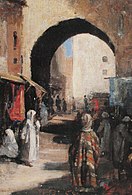 City Gate in Fez, 1858
City Gate in Fez, 1858 -
 Alley in Fez, 1858
Alley in Fez, 1858 -
 Street scene in Algiers, c. 1850
Street scene in Algiers, c. 1850 -
 Crouching Moroccan, c. 1858.
Crouching Moroccan, c. 1858. -
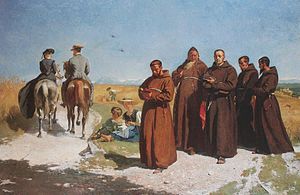 Asceticism and zest for life, 1865
Asceticism and zest for life, 1865 -
 Portrait of Johann August Sutter, 1866
Portrait of Johann August Sutter, 1866 -
 Fort Laramie, 30 August 1866
Fort Laramie, 30 August 1866 -
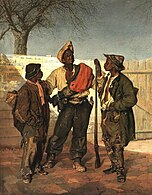 The volunteers return, 1867.
The volunteers return, 1867. -
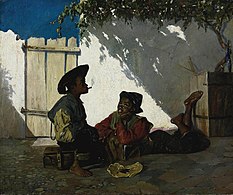 Dolce far niente ("Doing Nothing") 1867
Dolce far niente ("Doing Nothing") 1867 -
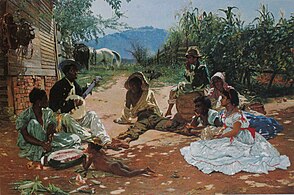 The Song of Mary Blane, Charlottesville, Virginia, 1870.
The Song of Mary Blane, Charlottesville, Virginia, 1870. -
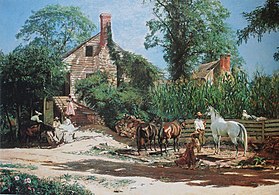 Old Virginia, c. 1870
Old Virginia, c. 1870 -
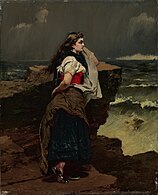 Fishergirl by the Sea, depicting "Fanny", undated.
Fishergirl by the Sea, depicting "Fanny", undated. -
 Flood encirclements, 1876, depicting Fanny.
Flood encirclements, 1876, depicting Fanny. -
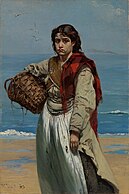 Young girl with a basket on the beach, 1876, depicting Fanny.
Young girl with a basket on the beach, 1876, depicting Fanny. -
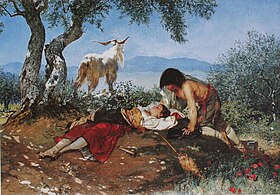 The Kiss, 1878.
The Kiss, 1878. -
 The divine swineherd, 1882.
The divine swineherd, 1882.
References
- ^ "Swiss painter kept an eye on US history". swissinfo.ch. 12 June 2009. Retrieved 14 October 2012.
- ^ Carrino, D.A., "Europe's Artistic Ambassador to the Post-Civil War United States," History Briefs,The Cleveland Civil War Roundtable, February, 2011
- ^ Wälchlim G., Frank Buchser, 1828-1890; Leben und Werk, Zürich, Leipzig, Orell Füssli, 1941
- ^ Thrapp, D.L., Encyclopedia of Frontier Biography: A-F, University of Nebraska Press, 1991, p. 185
- ^ Carrino, D.A., [Roundtable Historian], History Briefs: 2011 - 2012, The Cleveland Civil War Roundtable, 2011, Online: http://clevelandcivilwarroundtable.com/articles/comment/history_briefs12.htm Archived 2017-10-01 at the Wayback Machine
- ^ Burns, S. and Davis, J., American Art to 1900: A Documentary History, University of California Press, 2009, p.536
- ^ Wallace-Sanders, k., Skin Deep, Spirit Strong: The Black Female Body in American Culture, University of Michigan Press, 2002, p.123; Moriarty, S., "The 'Negro-Pictures' of Frank Buchser: Romantic Representation of Blackness in America," SECAC Conference Proceedings, New Orleans, Louisiana, September 24–27, 2008
- ^ Brun, C., "Buchser, Frank," in General German Biography (ADB), Vol. 47, Leipzig, Duncker & Humblot, 1903, pp. 330-332
- ^ Kunstmuseum Basel, From Arcadia to Atlanta: Photographs from the Estate of Frank Buchser (1828–1890), 2009, ISBN 978-3-86678-258-7; Christoph Vögele: Erweiterungsbau für das Kunstmuseum Solothurn. Motivation und Perspektiven Archived 2016-03-04 at the Wayback Machine (PDF; 64 kB)





























